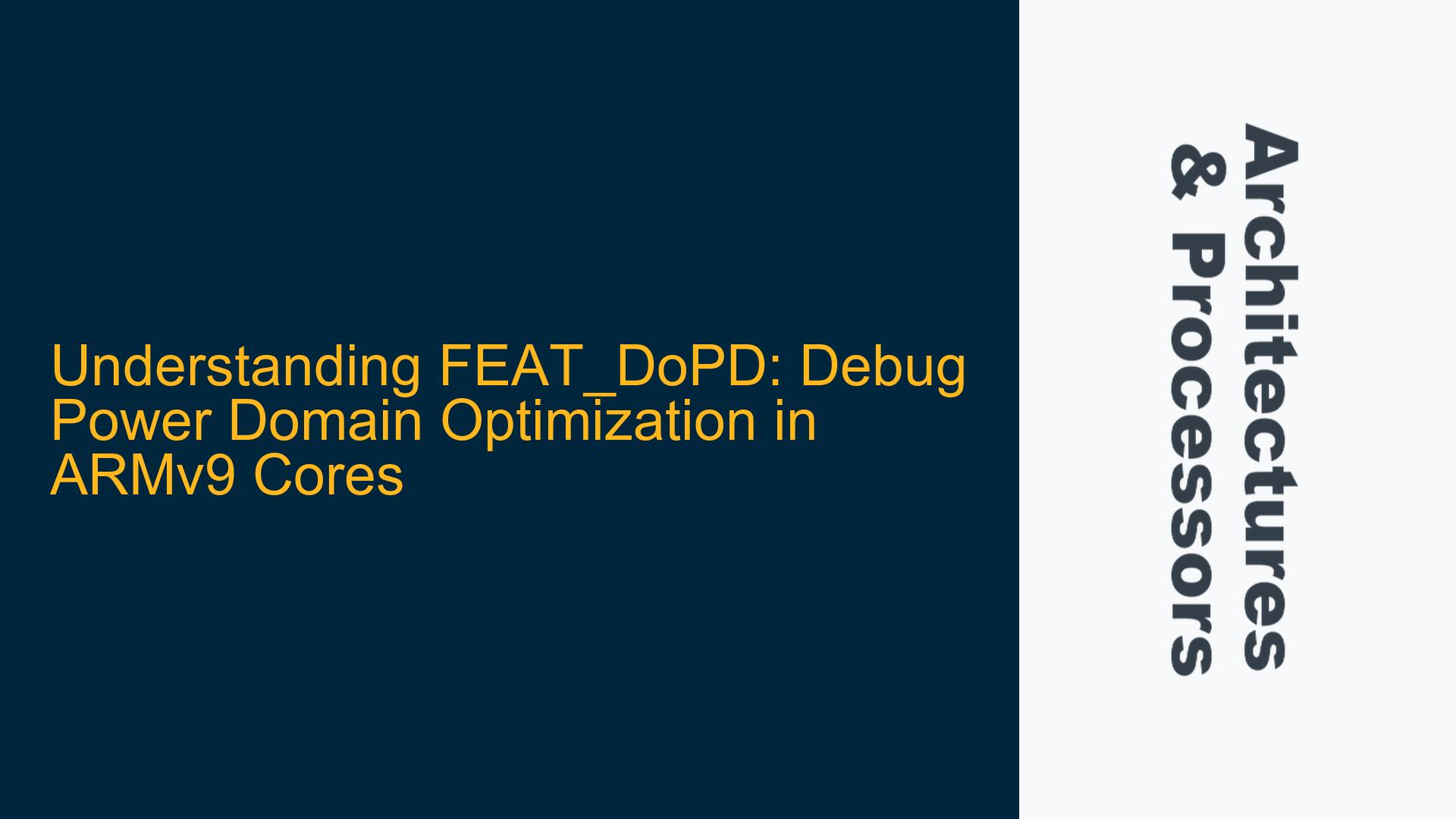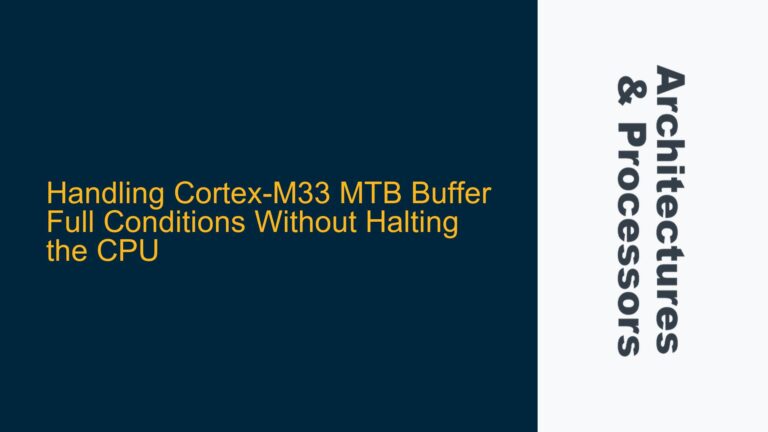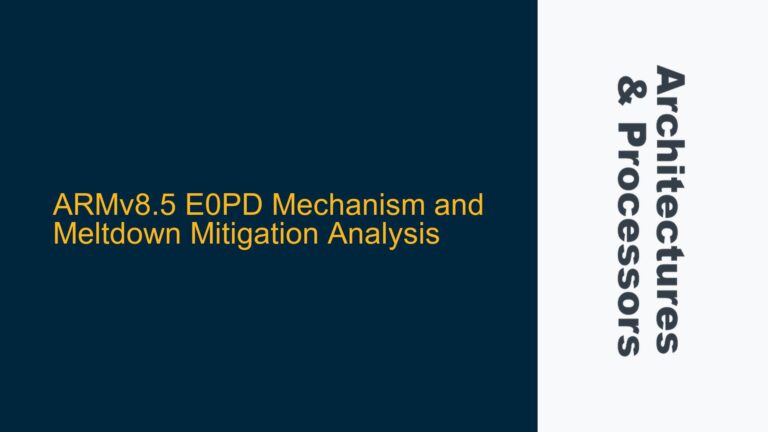ARMv9 FEAT_DoPD: Debug Power Domain Reconfiguration and Its Implications
The introduction of FEAT_DoPD (Debug Power Domain) in ARMv9 architecture marks a significant shift in how debug resources are managed within DynamIQ-based cores. Historically, DynamIQ cores utilized a separate DebugBlock, which allowed for the isolation of debugging logic into its own power domain. This separation was designed to enhance power efficiency by enabling the debugging logic to be powered down independently of the core when not in use. However, ARMv9 cores with FEAT_DoPD have reverted this design by moving most external debug registers back from the debug power domain to the core power domain. This change has raised questions about its rationale and implications for system design, debugging workflows, and power management.
To understand the reasoning behind this architectural shift, it is essential to delve into the intricacies of power domain management, debug resource accessibility, and the trade-offs involved in isolating debug logic. The DebugBlock in DynamIQ cores was initially introduced to provide a dedicated power domain for debugging, allowing the core to enter low-power states without affecting the debug logic. This separation was particularly beneficial in scenarios where continuous debugging was required while the core itself was in a sleep or idle state. However, this design also introduced complexities in terms of power domain transitions, signal integrity, and timing synchronization between the core and the debug logic.
With FEAT_DoPD, ARM has opted to move most external debug registers back to the core power domain. This decision is driven by several factors, including the need to simplify power domain management, reduce latency in debug register access, and improve overall system reliability. By integrating debug resources into the core power domain, ARM aims to streamline the power-up and power-down sequences, ensuring that debug registers are always accessible when the core is active. This reconfiguration also addresses potential issues related to signal propagation delays and synchronization mismatches that could arise when debug logic operates in a separate power domain.
The implications of this change are multifaceted. On one hand, it simplifies the power management architecture by reducing the number of independent power domains that need to be controlled. On the other hand, it necessitates a reevaluation of debugging strategies, particularly in scenarios where low-power operation is critical. Developers must now consider the impact of core power state transitions on debug accessibility and ensure that debug resources are available when needed, even during low-power modes.
Debug Power Domain Isolation vs. Core Integration: Trade-offs and Challenges
The decision to move external debug registers back to the core power domain in ARMv9 cores with FEAT_DoPD is rooted in a careful analysis of the trade-offs between power efficiency, debug accessibility, and system complexity. The initial approach of isolating debug logic into a separate DebugBlock power domain offered clear advantages in terms of power savings, as the debug logic could be powered down independently of the core. However, this separation also introduced several challenges that ultimately led to the reconfiguration seen in FEAT_DoPD.
One of the primary challenges associated with the DebugBlock power domain isolation was the increased complexity in power domain management. In systems with multiple power domains, coordinating the power-up and power-down sequences becomes a non-trivial task. The DebugBlock, being in a separate power domain, required additional control logic to ensure that it was powered on and off in sync with the core. This added complexity not only increased the design overhead but also introduced potential points of failure in the power management sequence.
Another significant challenge was the latency introduced by the separation of debug logic from the core. When debug registers were located in the DebugBlock power domain, accessing these registers required crossing power domain boundaries, which could introduce delays due to signal propagation and synchronization requirements. These delays could impact the responsiveness of the debug interface, particularly in real-time debugging scenarios where quick access to debug registers is critical.
Furthermore, the isolation of debug logic in a separate power domain posed challenges in terms of signal integrity and timing synchronization. Ensuring that signals between the core and the DebugBlock remained stable and synchronized across power domain transitions required careful design and validation. Any mismatch in timing or signal integrity could lead to unreliable debug behavior, making it difficult to diagnose and resolve issues during development.
In contrast, integrating debug resources into the core power domain simplifies these challenges by eliminating the need for separate power domain control and reducing the latency associated with accessing debug registers. This integration ensures that debug resources are always available when the core is active, improving the overall reliability and responsiveness of the debug interface. However, this approach also means that debug resources are tied to the core’s power state, which could limit the ability to perform debugging operations when the core is in a low-power mode.
Optimizing Debug Accessibility and Power Management with FEAT_DoPD
The reconfiguration of debug power domains in ARMv9 cores with FEAT_DoPD represents a strategic optimization aimed at balancing the competing demands of power efficiency and debug accessibility. By moving external debug registers back to the core power domain, ARM has streamlined the power management architecture while ensuring that debug resources remain accessible during critical phases of operation. This section explores the practical implications of this change and provides guidance on how to optimize debug accessibility and power management in systems leveraging FEAT_DoPD.
One of the key benefits of integrating debug resources into the core power domain is the simplification of power management sequences. With debug registers now residing in the same power domain as the core, the need for complex power domain coordination is eliminated. This simplification reduces the design overhead and minimizes the risk of power management-related issues, such as incomplete power-up sequences or unintended power-down events. Developers can now focus on optimizing the core’s power states without having to account for the additional complexity of managing a separate debug power domain.
However, this integration also requires careful consideration of the core’s power states and their impact on debug accessibility. In systems where low-power operation is a priority, it is essential to ensure that debug resources remain accessible even when the core is in a low-power mode. This can be achieved through the use of power management techniques that selectively retain power to critical portions of the core, including the debug registers, during low-power states. By carefully configuring the core’s power management policies, developers can strike a balance between power efficiency and debug accessibility.
Another important consideration is the impact of FEAT_DoPD on real-time debugging scenarios. With debug registers now integrated into the core power domain, the latency associated with accessing these registers is significantly reduced. This improvement in responsiveness is particularly beneficial in real-time debugging, where quick access to debug information is crucial for diagnosing and resolving issues. Developers should take advantage of this enhanced responsiveness by optimizing their debugging workflows and leveraging the improved access to debug registers.
In addition to optimizing power management and debug accessibility, developers should also consider the implications of FEAT_DoPD on system reliability and validation. The integration of debug resources into the core power domain simplifies the validation process by reducing the number of power domain transitions that need to be tested. However, it is still important to thoroughly validate the system’s power management and debug functionality to ensure that all potential edge cases are covered. This includes testing the system’s behavior during power state transitions, as well as verifying the integrity and accessibility of debug registers in various operating conditions.
In conclusion, the introduction of FEAT_DoPD in ARMv9 cores represents a significant evolution in the management of debug power domains. By moving external debug registers back to the core power domain, ARM has simplified the power management architecture while improving the accessibility and responsiveness of debug resources. Developers must carefully consider the implications of this change and optimize their systems to leverage the benefits of FEAT_DoPD while addressing the challenges associated with core power state management. Through careful design and validation, it is possible to achieve a balance between power efficiency and debug accessibility, ensuring reliable and efficient operation of ARMv9-based systems.






